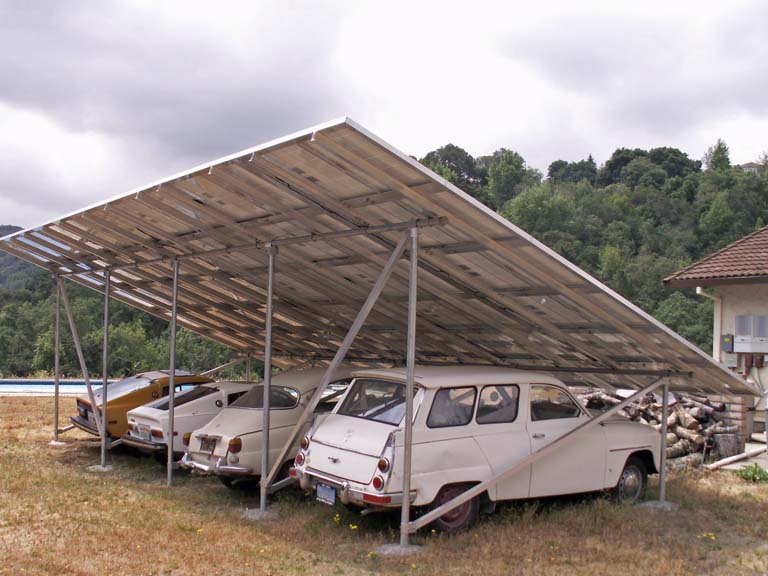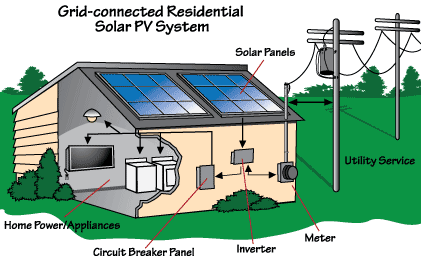Thinking of going PV solar to offset the electricity used to charge the car. Has anyone built or is currently using a solar array on a steel framed carport to charge up their car? What size is your system, brand of solar panels, number of solar panels, brand of inverter?Were you able to claim the carport as part of the total project? (30% FED solar energy tax write off).
You are using an out of date browser. It may not display this or other websites correctly.
You should upgrade or use an alternative browser.
You should upgrade or use an alternative browser.
Solar carport for a iMiEV.
- Thread starter iMiEV808
- Start date

Help Support Mitsubishi i-MiEV Forum:
This site may earn a commission from merchant affiliate
links, including eBay, Amazon, and others.
Solar is the way to go IMO. I'm using my ground-mounted 6.6kW grid-tied solar array as a carport for four cars. Here's an old photo when I still had my Saab Sonetts:

My panels are Sharp, the grid-tied inverters are Xantrex, and I got some tax breaks, but it was built before the dramatic price decreases of the last few years. - the penalty for being an early adopter.
Depending on how you want to do it,, there are lots of low-cost opportunities out there. If you have limited space, then the efficient (but more expensive) SunPower modules are nice. Here in California massive solar systems are being put into school parking lots as carports.

My panels are Sharp, the grid-tied inverters are Xantrex, and I got some tax breaks, but it was built before the dramatic price decreases of the last few years. - the penalty for being an early adopter.
Depending on how you want to do it,, there are lots of low-cost opportunities out there. If you have limited space, then the efficient (but more expensive) SunPower modules are nice. Here in California massive solar systems are being put into school parking lots as carports.
FiddlerJohn
Well-known member
Good question. I am interested in the answer.iMiEV808 said:... anyone ... using a solar array ... to charge their car? ... 30% FED solar energy tax write off.
Tax Credit: 30% of cost. $500 per .5 kW of power capacity. Expires: December 31, 2016
http://www.energystar.gov/index.cfm?c=tax_credits.tx_index
The 30% investment tax credits (ITC) for solar energy
http://www1.eere.energy.gov/buildings/tax_commercial.html
jennrod12
Well-known member
Nice carport, Joe!
I got into PV early, too. My personalized plates (moving onto my i-MiEV as soon as the real plates come in) say PV POWR.
Jenn
I got into PV early, too. My personalized plates (moving onto my i-MiEV as soon as the real plates come in) say PV POWR.
Jenn
rokeby
Active member
JoeS,
For those of us who are e-challenged, could you explain how the PV electricity
ends up in the car's HV battery. For simplicity, pretend that I'm an 8th grader.
For those of us who are e-challenged, could you explain how the PV electricity
ends up in the car's HV battery. For simplicity, pretend that I'm an 8th grader.
rokeby, good question, and I like fjpod's comment 
In a nutshell, for most conventional home-solar systems, the "dc" (direct current) electricity from the photovoltaic solar panels gets converted into "ac" (alternating current) which is then fed FROM your house INTO the "Grid" (another name for the network of powerlines delivering the electricity to your home).
Think of the Grid as simply a place to store electricity, which is measured in kilowatt-hours (kWh). The power utility measures and keeps track of the kWh difference between what you generate at home and what you consume at home, and bills you accordingly (giving you credit for what you generate).
Your electric car is nothing more than an electrical consumer, just like a clothes dryer or refrigerator. It takes the ac from the wall socket (Grid) and goes through the iMiEV's very sophisticated onboard battery charger which converts the ac into the appropriate dc level to charge the car's high-voltage battery.
There are many other schemes for storing the electricity that is generated by the solar panels, but this is the most conventional present-day configuration.
Hope this helps.
In a nutshell, for most conventional home-solar systems, the "dc" (direct current) electricity from the photovoltaic solar panels gets converted into "ac" (alternating current) which is then fed FROM your house INTO the "Grid" (another name for the network of powerlines delivering the electricity to your home).
Think of the Grid as simply a place to store electricity, which is measured in kilowatt-hours (kWh). The power utility measures and keeps track of the kWh difference between what you generate at home and what you consume at home, and bills you accordingly (giving you credit for what you generate).
Your electric car is nothing more than an electrical consumer, just like a clothes dryer or refrigerator. It takes the ac from the wall socket (Grid) and goes through the iMiEV's very sophisticated onboard battery charger which converts the ac into the appropriate dc level to charge the car's high-voltage battery.
There are many other schemes for storing the electricity that is generated by the solar panels, but this is the most conventional present-day configuration.
Hope this helps.
rokeby
Active member
JoeS,
Now I get it.
Ya done good.
Do you ever use the PV originated electricty directly as shown in this
graphic, or would that also involve batteries:

And does the electric company buy power from you at the same rate
they sell theirs to you? (I would expect not.)
Now I get it.
Ya done good.
Do you ever use the PV originated electricty directly as shown in this
graphic, or would that also involve batteries:

And does the electric company buy power from you at the same rate
they sell theirs to you? (I would expect not.)
rokeby, the picture is a good illustration of what I had described. The dc from the solar panels goes to the inverter which converts it into ac in synchronization with the grid. Where that current goes depends on the loads in your house: if the house is consuming less than what is being generated by the panels (through the inverter), then the excess goes out of the house into the grid. If the house consumes more than is being generated, then the current flows from the grid to the house, adding to what the PV system produces. Technically, your drawing does not specifically show the PV-originated electricity being used directly, but does shows it complementing the grid-originated electricity.
There are other schemes for storing electricity, batteries being most common. I have such a backup system whereby the solar panels drive a battery charger which charges and maintains a battery bank. If the grid goes down, I simply use the dc from this battery bank to drive an inverter which puts out ac that is usable by my home's lights and appliances (and iMiEV charger). How much power this system can put out and for how long it does this is simply dictated by how big a backup battery and inverter I want to spend $$ on.
You may have heard the expression V2G (Vehicle-to-Grid), where the electric car's battery is used as the source of energy which gets fed into the grid. This concept can provide the utility with a much-needed buffer to handle peak loads.
Allied to this concept I can, in a matter of a few minutes, easily hook up some battery chargers to my other electric cars to feed my backup battery bank to keep me happily living "off-grid" should we lose power again like we did for a week after the Loma Prieta earthquake. Hopefully my solar panels and garage survive the earthquake so I can do this...
Regarding what the electric company does for payback - the schemes and rate structures vary from state-to-state. For example, in my service area in California, my PV system can be used to bring my electricity bill down to zero at the same rate as would have been charged me. Don't get me started on issues with how that works in real life...
There are other schemes for storing electricity, batteries being most common. I have such a backup system whereby the solar panels drive a battery charger which charges and maintains a battery bank. If the grid goes down, I simply use the dc from this battery bank to drive an inverter which puts out ac that is usable by my home's lights and appliances (and iMiEV charger). How much power this system can put out and for how long it does this is simply dictated by how big a backup battery and inverter I want to spend $$ on.
You may have heard the expression V2G (Vehicle-to-Grid), where the electric car's battery is used as the source of energy which gets fed into the grid. This concept can provide the utility with a much-needed buffer to handle peak loads.
Allied to this concept I can, in a matter of a few minutes, easily hook up some battery chargers to my other electric cars to feed my backup battery bank to keep me happily living "off-grid" should we lose power again like we did for a week after the Loma Prieta earthquake. Hopefully my solar panels and garage survive the earthquake so I can do this...
Regarding what the electric company does for payback - the schemes and rate structures vary from state-to-state. For example, in my service area in California, my PV system can be used to bring my electricity bill down to zero at the same rate as would have been charged me. Don't get me started on issues with how that works in real life...
Similar threads
- Replies
- 5
- Views
- 869
- Replies
- 5
- Views
- 4K
- Replies
- 9
- Views
- 8K